Supervised theses
- Colby SingintWalker, "Effect of X-Ray Illumination on Magnetic Domain Memory in [Co/Pd]/IrMn Multilayers" (Masters Thesis, 2022). Full Text PDF
- MichaelVaka, "Mapping In-situ Morphological Phase Transitions of Magnetic Domains in [Co/Pt]_N Multilayers" (Senior Thesis, 2022). Full Text PDF
- Johnathon MichaelRackham, "Modeling Inter-Particle Magnetic Correlations in Magnetite Nanoparticle Assemblies Using X-ray Magnetic Scattering Data" (Masters Thesis, 2022). Full Text PDF
- DanielMcPherson, "Exploring the Dynamics of Magnetic Fluctuations in Magnetite Nanoparticles" (Senior Thesis, 2021). Full Text PDF
- MasonParkes, "Investigating a loss of Magnetic Domain Memory in a [Co/Pd]/IrMn Thin film" (Senior Thesis, 2019). Full Text PDF
- AlexCahoon, "Instrumental Developments for a Surface Magneto-Optical Kerr Effect (SMOKE) Magnetometer" (Capstone, 2019). Full Text PDF
- BrittniNewbold, "Modeling the Magnetic Ordering of Magnetite (Fe3O4) Nanoparticle Assemblies" (Senior Thesis, 2018). Full Text PDF
- DaltonGriner, "Study of Magnetite Nanoparticle Assemblies Using X-ray Resonance Magnetic Scattering (XRMS)" (Senior Thesis, 2016). Full Text PDF
- MatthewHealey, "Topology of the Magnetic Domains of a Co/Pt Multilayer with 16Å Cobalt Layers" (Capstone, 2016). Full Text PDF
- DallinSmith, "X-ray Studies and Magnetic Ordering Modeling of Chains of Magnetite Nanoparticles" (Senior Thesis, 2016). Full Text PDF
- AlexSafsten, "Mapping Magnetic Memory in [Co/Pd]IrMn Thin Films Under Exchange Bias Conditions" (Senior Thesis, 2015). Full Text PDF
- YanpingCai, "Spin and Orbital Moments and Magnetic Order in Fe3O4 Nanoparticle Assemblies" (Masters Thesis, 2014). Full Text PDF
- MateaTrevino, "Fabrication and Characterization of Superparamagnetic Magnetite (Fe3O4) Nanoparticles" (Senior Thesis, 2013). Full Text PDF
- AndrewWestover, "Evolution of Magnetic Domain Morphology in Co/Pt Thin Films" (Senior Thesis, 2012). Full Text PDF
- MatthewRytting, "Effect of Field Cooling on Magnetic Domain Memory in Exchange Coupled Thin Films" (Senior Thesis, 2012). Full Text PDF
- YoungwoongByun, "Exchange Bias in [Co/Pd]/IrMn Thin Films" (Senior Thesis, 2011). Full Text PDF
- JosephNelson, "Spatial And Temperature Dependence Of Magnetic Domain Memory Induced By Exchange-Coupling" (Senior Thesis, 2010). Full Text PDF
- BrianWilcken, "Magnetic Memory In Exchange Bias Thin Films" (Senior Thesis, 2009). Full Text PDF
Supervised REU projects:
- Adam Christiansen - August 2019
- Misael Campos - August 2019
Shelby Klomp - August 2018
"Fabrication and characterization of magnetite (Fe3O4) nanoparticles of controlled size"Luis Ortiz - August 2018
"Morphological phase transition of magnetic domains in [Co(12Å)/Pt(4Å)] multilayers"
Jeremy Metzner - August 2017
"Magnetic domain morphology in multilayers [Co(4Å)/Pt(4Å)] thin films""
David montelalegre - August 2016
Magnetic domain morphology in multilayers [Co(4Å)/Pt(4Å)] thin films""
Theses, Captstones, and Dissertations
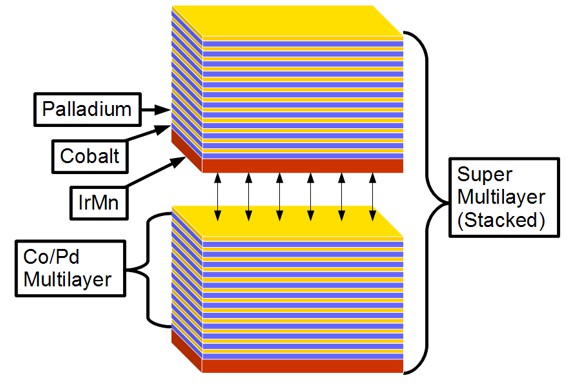
We have used the technique of coherent X-ray Resonant Magnetic Scattering (XRMS) to probe the magnetic domain morphologies in a ([Co/Pd]12IrMn)4 exchange bias thin
lm. When illuminated by coherent light, the thin
lm produces speci
c speckle patterns that reveal information about the local magnetic domain topology in the sample. After subjecting the sample to a variable magnetic
eld and collecting XRMS patterns, we have analyzed the amount of magnetic memory within the sample by employing a cross-correlation approach. Results indicate that, at low temperature, the sample shows very high magnetic memory in the coercive region of the magnetization cycle. In particular, the system exhibits strong return point memory (RPM) and conjugate point memory (CPM). The dependency of RPM and CPM on applied
eld will be presented
rst in a 1D and then in a 2D
eld analysis showing that the magnetic memory stays stable within the coercive region of the magnetization.
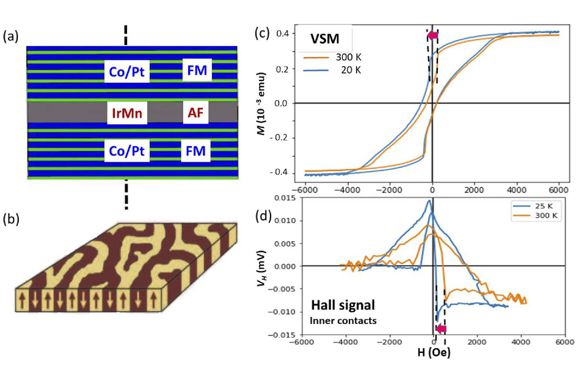
This thesis focuses on investigating the possible x-ray illumination effects on the magnetic domain memory (MDM) in magnetic [Co/Pd]IrMn multilayers. In this material, MDM is induced via exchange couplings between the ferromagnetic Co/Pd layer and the antiferromagnetic IrMn layer. To carry out this investigation, we have used magneto-transport and x-ray resonant magnetic scattering. The use of magneto-transport in-situ at synchrotron x-ray scattering facility has allowed us to follow the gradual effect of x-ray illumination on the amount of exchange bias, initially present after field cooling the material. With our in-situ measurements we have been able to see that x-ray illumination does have an effect on the strength of exchange couplings in our material. To support this observation, we have also carried out complementary measurements at home in a cryomagnet, at various temperatures between 300K and 25K, and in a variety of configurations.
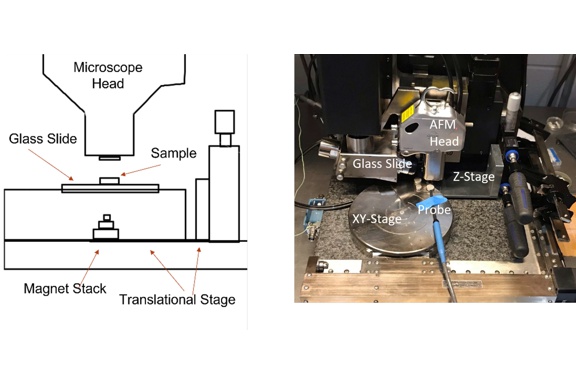
Nanomagnetism is a growing field with many applications from bio-medicine to high-density magnetic storage. Co/Pt multilayers display ferromagnetic domains with perpendicular magnetic anisotropy with distinct morphologies that may be used in magnetic data storage devices. The morphology of the magnetic domains in $[\text{Co/Pt}]_\text{N}$ multilayer thin films is characterized by types of patterns, such as bubble, stripe, and maze. Previous studies at remanence show that these patterns depend on the number of bilayer repeats, N, the Co thickness, and magnitude of the previously applied field. The Domain density is a key metric for quantifying transitions between these morphological phases. To gain insight into these morphological processes, we map the domain density as a response to the in-situ field, $H$, and maximum applied field, $H_m$, using Magnetic Force Microscopy (MFM) up to an applied in-situ field of 7.2 kOe. We also mapped characteristics extracted from the Fourier transforms of the MFM images. We completed these studies for $[\text{Co(t),Pt( 7 \AA)}]_\text{20}$ with $\text{t} = 31$ \AA and 10 \AA. For the first time, we discover three in-situ morphological transitions that correlate to previously observed remanent morphological phases and we find that domain density generally increase with in-situ applied field.
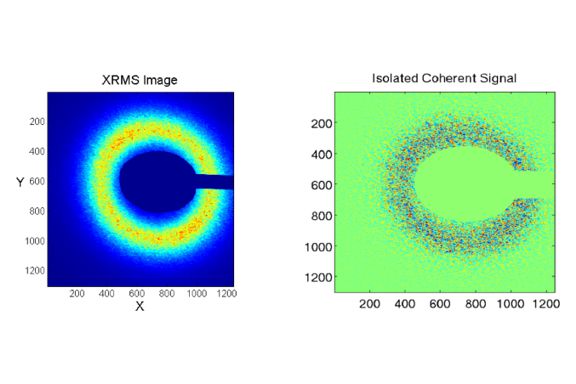
Magnetic nanoparticles are used in nanotechnologies and biomedical applications, such as drug targeting, hyperthermia, MRI contrasting agents, and bio-separation of compound solutions. Magnetite (Fe3O4) nanoparticles stand to be effective in these roles due to the non-toxic nature of magnetite and its ease of manufacture. To this end, a greater understanding of the magnetic behavior of the individual magnetite nanoparticles is needed when a collection of them is used. This research seeks to discover the local magnetic ordering of ensembles of magnetite nanoparticles at various stages of the magnetization process, temperatures above and below their blocking temperature, and for various particle sizes. We use x-ray circular dichroism and x-ray resonant magnetic scattering (XRMS), which provides information about the magnetic orders in the samples. Here we discuss the modeling of the magnetic scattering data using a one-dimensional chain of nanoparticles in real space as well as an empirical Gaussian packet model in reciprocal space. We find that at low temperature, and field values close to the coercive point, magnetite nanoparticles experience a significant amount of antiferromagnetic ordering that increases with particle size.
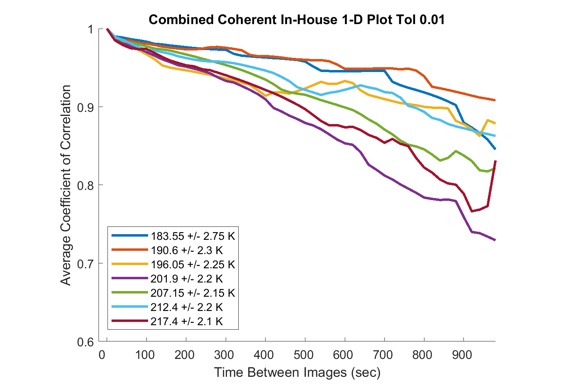
Magnetic nanoparticles have a wide range of applications, from the engineering to the medical field. Understanding the properties of assemblies of magnetic nanoparticles is necessary to enhance the effectiveness of their use. A key feature of self-assemblies of magnetite nanoparticles is their superparamagnetic behavior. My current project focuses on understanding the dynamics of magnetic fluctuations in magnetite (Fe3O4) nanoparticles. The method of study is using x-ray resonant magnetic scattering (XRMS). We collected our XRMS data at SSRL. We study variations in the XRMS signal caused by assemblies of magnetite nanoparticles. A certain amount of data refinement is necessary to isolate the coherent x-ray scattering signal, also known as magnetic speckle. Upon isolation of coherent signal, speckle patterns collected throughout 1000 second periods are cross-correlated in order to study the magnetic fluctuation dynamics. We compare two-time cross-correlation maps collected at different temperatures throughout the superparamagnetic blocking transition.
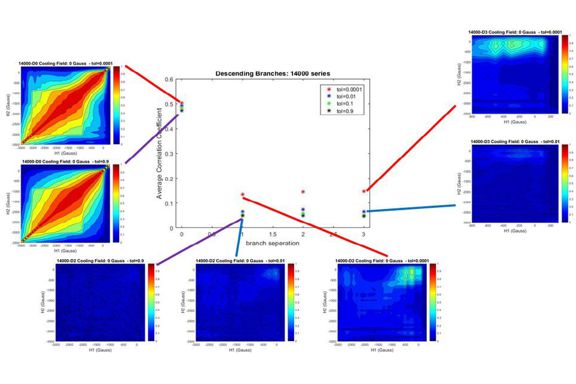
An investigation is made into the effect that certain parameters, such as smoothing tolerance and integration ellipse size, used to determine the degree of magnetic domain memory (MDM), have on the level of MDM observed. Decreasing the tolerance which results in more smoothing, and increasing the size of the integration ellipse both cause higher levels of MDM. Careful pairing of ellipse size and tolerance yields MDM maps with far higher degrees of observed MDM than maps that were originally generated for the series analyzed. This pairing of parameters yields MDM in the zero field cooling (ZFC) series examined to be higher than in the 5000 G field cooled (5000 G FC) series. This is consistent with previous results (Chesnel et al. 2016) and indicates that increased MDM in these maps is not purely artificial. While certain parameters were found to increase the degree of MDM, they still did not reach levels previously observed in this sample, and the search for a physical cause for the loss of MDM continues through efforts to investigate the effect of x-ray illumination on MDM.
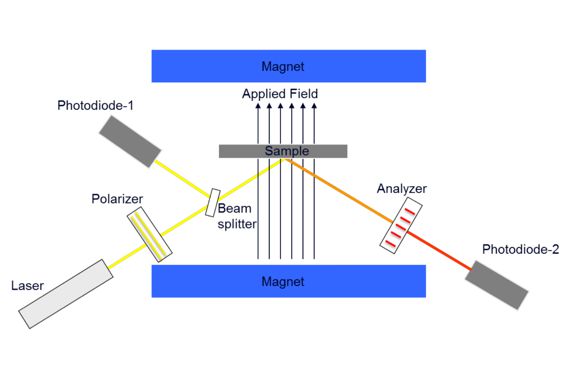
The Surface Magneto-Optical Kerr Effect (SMOKE) magnetometer is an instrument used to measure the out-of-plane magnetization of thin films made of ferromagnetic materials using polarized visible light. It does this by taking advantage of the Kerr effect which is a magnetic-optical interaction where the polarization of the light reflected from a magnetic surface is rotated approximately proportionally to the amount of magnetization in the material. We use the instrument to map hysteresis loops in ferromagnetic thin film multilayers by applying a varying external magnetic field to the sample while simultaneously measuring the polarization rotation. My project has consisted of upgrading the physical SMOKE apparatus: we have improved the mechanical stability and introduced new features that will allow us to alter the incident angle between the sample and the polarized light, as well as give us the ability to translate samples so that we can study different sections of the samples without having to remount them.
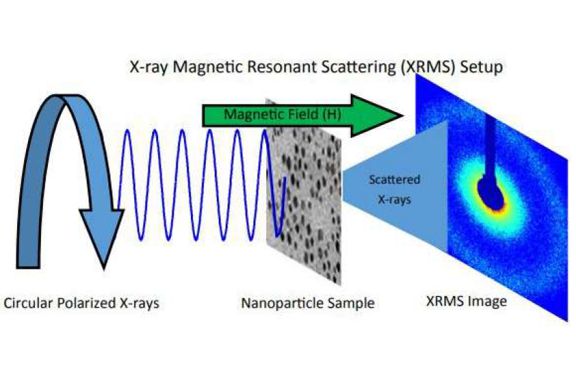
Magnetite nanoparticles have great potential for use in medical and other applications, so understanding their properties is crucial. A property still left to be understood is the magnetic ordering of assemblies of nanoparticles at the nanoscale. This paper addresses how the magnetic ordering in magnetite nanoparticle assemblies changes as a function of nanoparticle size and external magnetic field at high temperature. Nanoparticle assemblies were fabricated using organic methods and placed on membranes. These samples were put through x-ray resonant magnetic scattering (XRMS) which produced scattering images that provided information about the magnetic ordering of the particles. Various images were obtained using XRMS for different field values and temperatures. These images were reduced to one-dimensional scattering profiles. By fitting these scattering profiles with a model, we found the percentages of ferromagnetic contribution, antiferromagnetic contribution, and the random contribution. There is a large random contribution as the field value approaches 0 Oe for Sample 9, the sample with the smallest particles, at 300 K. For Sample 3, the sample with the largest particles, at 280 K and at 300 K, there is a slight increase in the antiferromagnetic contribution and large random contribution at low field value. The larger particles are thus demonstrating more antiferromagnetic ordering at low magnetic field values than the smaller particles when placed in high temperature. Therefore, our methods yield information about the magnetic ordering of magnetite nanoparticles and the possibility to control the magnetic ordering through particle size.
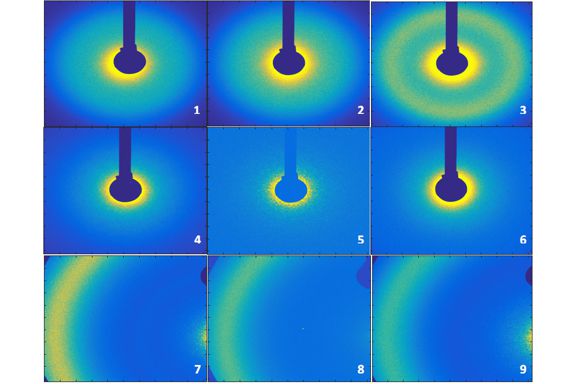
Magnetic nanoparticle technology is changing the world with important applications in healthcare such as more effective cancer treatments and drug delivery systems. To understand the magnetic behavior of Fe3O4 (known as magnetite) nanoparticles when forming assemblies, we have studied them with x-ray diffraction techniques. We used organic solution methods to create nanoparticles with different particle sizes ranging from 5 to 11 nm. Using X-ray Diffraction (XRD) and Transmission Electron Microscopy (TEM), we finely measured the average particle size and distribution. Using the synchrotron at the Stanford Synchrotron Radiation Lightsource (SSRL) at Stanford Linear Accelerator Center (SLAC), X-ray Circular Magnetic Dichroism (XMCD) and X-ray Resonance Magnetic Scattering (XRMS) experiments were conducted at different temperatures and magnetic fields on the freshly made samples. From this data, spin and orbital magnetic moments, as well as magnetic profiles, were extracted that provide information about the magnetic order in the nanoparticle assembly and its dependency on particle size, concentration, and temperature.
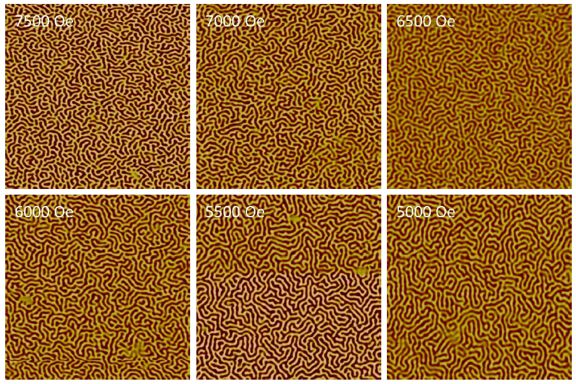
It was recently established, through MFM microscopy, that the magnetic domain topology in Co/Pt (cobalt-platinum) multilayered thin films can be influenced by the magnetic history of the material (i.e. the magnetic path which the material has been exposed to). Particularly, it appears that the domain topology at remanence drastically depends on the magnitude of the field previously applied perpendicular to the material. A maximum density of domains is obtained after a magnetic field of appropriate strength has been applied. We are expanding this study by showing that the appropriate field strength necessary for maximum magnetic domain density in a Co/Pt multilayer depends on the thickness of the cobalt layers. By performing MFM microscopy on a sample with thicker (16Å) cobalt layers than the ones used for the preliminary study (8Å), we found that the magnetic domain density is maximized at a greater magnetic field magnitude than for thinner cobalt layers, in agreement with the associated increase of saturation field.
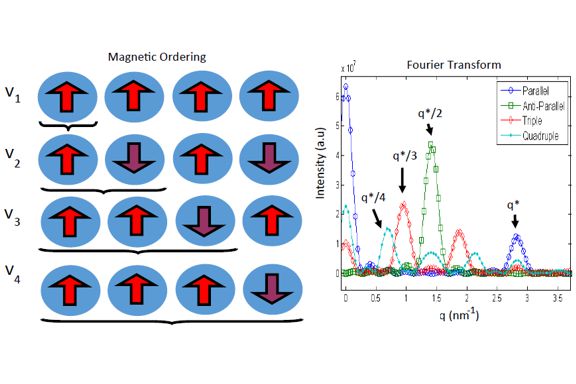
The study of magnetic nanoparticles has attracted attention for biomedical and nanotechnology research. Magnetite Fe$_{3}$O$_{4}$ is a ferrimagnetic nanoparticle carrying a macro-magnetic spin. When the nanoparticles self-assemble on a membrane, they interact with each other and demonstrate a superparamagnetic behavior. To understand these properties, we use several x-ray techniques: x-ray absorption spectroscopy (XAS), x-ray magnetic circular dichroism (XMCD) and x-ray magnetic resonant scattering (XRMS). With these procedures we can study the electronic structure and obtain a magnetic profile for the nanoparticles. Having acquired such data at the SLAC synchrotron, we examined different nanoparticles sizes and concentrations, at different x-ray energies and various temperatures and under the application of different magnetic field strengths. Models were made to fit the experimental data to outline the physical structure and the magnetic order from the XMCD and XRMS experiments. More importantly, the modeling concluded about the magnetic order of the specific magnetic spin configuration of the nanoparticle assembly, under the application of a given magnetic field at a given temperature.
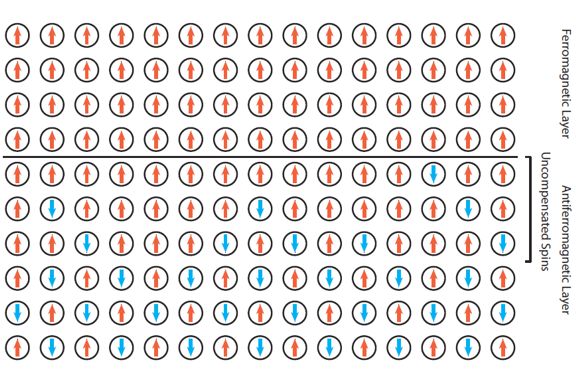
Magnetic domain memory (MDM) is the tendency of a magnetic material to recall its domain pattern after a disturbance resulting from an application of an external magnetic field. In general, magnetic materials do not exhibit this property, but some specialized thin films composed of layered ferromagnetic and antiferromagnetic materials do display magnetic memory. We measure the amount of memory of such films using the x-ray resonant magnetic scattering (XRMS) technique, and use a speckle-correlation technique to quantify the degree of magnetic memory in the sample. In particular, we examine how the magnetic memory in these films persists when we introduce an exchange bias between the ferromagnetic and the antiferromagnetic layers. We find that when bias is applied to the sample, the magnetic memory persists. However, the amount of memory and its behavior throughout the magnetization loop varies with the magnitude of the bias applied. We further find that the amount of memory and its behavior throughout the magnetization loop does not, however, vary much with multiple magnetization loop passes.
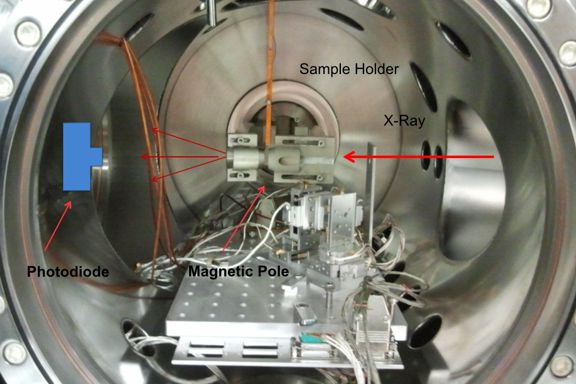
Fe3O4 magnetic nanoparticles of 5 to 11 nm in size were prepared by organic methods. Particle size was analyzed by both X-ray Diffraction (XRD) and Transmission Electron Microscopy (TEM) techniques. Zero Field Cooling (ZFC) / Field Cooling (FC) and magnetization loop measurements were recorded by VSM, and they confirmed superparamagnetic behavior in the sample. The blocking temperature is found to be in the range of 30 K ⇠ 170 K. It has a dependence on the particle size. ZFC / FC curves also indicate the presence of magnetic coupling between particles. X-ray Magnetic Circular Dichroism (XMCD) measurements of these nanoparticles were measured at 80 K and 300 K. By using the sum rules, spin and orbital magnetic moments were calculated from the XMCD signal. The results confirm a quenching orbital moment and a large spin moment. The calculated total magnetic moments are somewhat smaller than in bulk Fe3O4. Also, the spin moment at 80 K was found to be larger than at 300 K. X-ray Resonant Magnetic Scattering (XRMS) measurements at different temperatures, polarizations and fields were carried out. The intensity profile gives information on the interparticle distance between nanoparticles which is consistent with TEM results. A magnetic signal was extracted by calculating the dichoroic term, when the energy is tuned to resonant edges. This magnetic signal is confirmed by comparing the dichroic terms at different conditions.
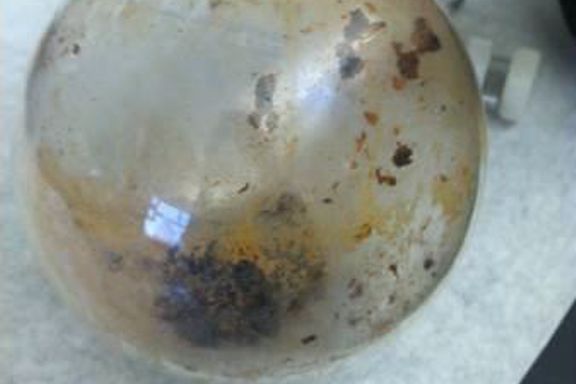
In this thesis, we will discuss the fabrication of magnetite (Fe3O4) nanoparticles, their structural characterization through X-ray Diffraction (XRD) and Transmission Electron Microscopy (TEM), and their magnetic characterization through Vibrating Sample Magnetometer (VSM). XRD will give us information about the crystallite quality of the nanoparticles and their average size. TEM will allow us to visualize the nanoparticles, when deposited on a substrate. We will then do bulk magnetization characterization using the VSM. For when they are small enough, magnetite nanoparticles follow a special magnetic behavior called superparamagnetism. This behavior is characterized by a blocking temperature, below which the particles are magnetically frozen. We learn that our nanoparticles show different structural and magnetic properties depending on the preparation method.
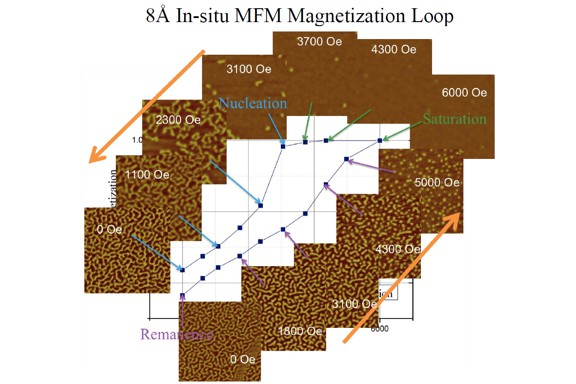
Cobalt (Co)/Platinum (Pt) thin films form into magnetic domains on a microscopic scale that align perpendicular to the film. This property makes them of particular interest for usage in ultra-high-density magnetic storage. Vibrating Sample Magnetometry (VSM), Extraordinary Hall Effect Magnetometry (EHE), and Magnetic Force Microscopy (MFM) was used to study the magnetic domain periodicity and hysteresis behavior of Co/Pt thin films with variable Co thickness ranging from 4Å to 60Å. As the thickness of Co increases, the domain periodicity increases and the relative amount of hysteresis decreases. The effect of applying major and minor magnetization loops of varying intensities to these samples was also studied, using MFM to observe the domain morphologies at remanence. The MFM images show that the domain morphology can vary from a long strip state to a bubble state depending on the intensity of magnetization loop applied.
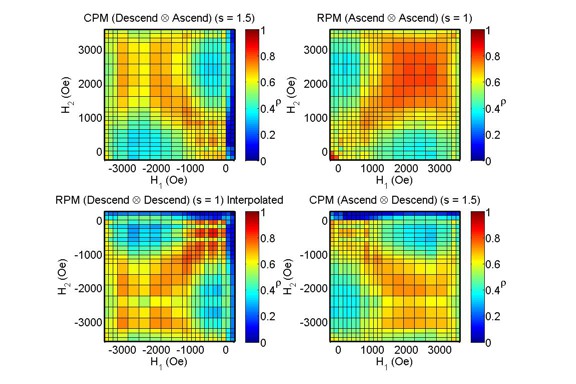
It has been found that magnetic domain memory can be induced in ferromagnetic thin films via exchange coupling with a antiferromagnetic layer. This effect was first observed in a zero field cooling state (that is, after cooling the material below the blocking temperature in the absence of an external magnetic field). In this project, we explored the effect on magnetic domain memory when the sample is field cooled (cooled in the presence of an external field). Our sample consists of multilayers of [Co/Pd] paired with an antiferromagnetic IrMn alloy. This combination exhibits exchange coupling. We used X-ray Resonant Magnetic Scattering to study the domain morphology. We analyzed the data using a cross-correlation technique. The results of our study show that the material gradually loses memory when the sample has undergone field cooling as well as that the region of highest memory is shifted due to exchange bias.
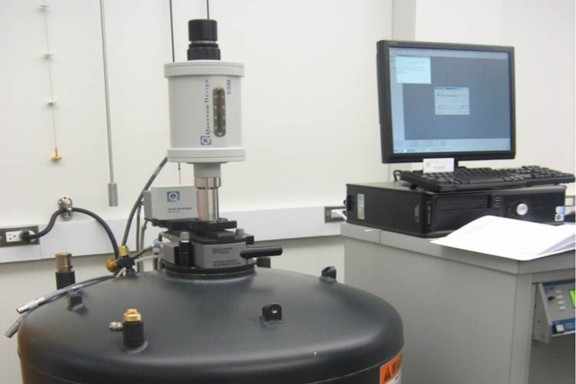
We are studying ferromagnetic materials made of Co/Pd multilayers. Vibrating Sample Magnetometery (VSM) is one of the magnetometery instruments for determining magnetic properties in high magnetic fields and in a temperature range of 10 - 400 K. My research project is to measure exchange bias effects in Co/Pd ferromagnetic multilayers interfaced with IrMn anti-ferromagnetic layers. This system, made at Hitachi, presents magnetic domains in the range of 200 nm in width. The magnetization in the domains is alternatively pointing up and down, perpendicular to the layer. The question is to understand the behavior of the net magnetization with applied field and study bias effects in different field cooling conditions. We have studied the film in various states such as field-cooling states and zero-field-cooled states, and we have also studied the remanent coercive point.
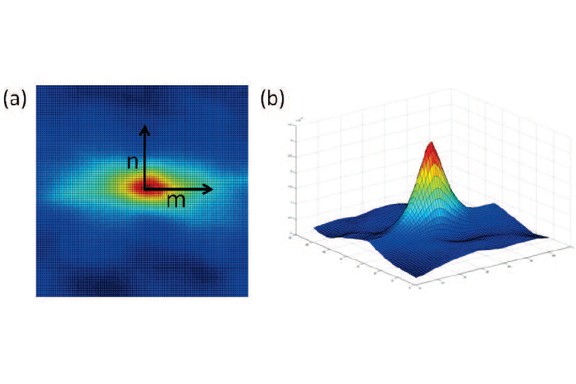
Exchange-bias [CoPd]/IrMn thin fi
lms with perpendicular magnetization have shown evidence of magnetic domain memory [1]. Using cross-correlation metrology on x-ray resonant magnetic scattering data, together with magnetometry measurements performed here at BYU, we have quanti
fied this memory, and have determined its dependence on
field cycling (fi
eld magnitude across the magnetic hysteresis loop). We have also studied how this domain memory changes with spatial scales and with temperature. We
find the domain memory to be over 95% at the spatial scale corresponding to the average domain periodicity. This memory remains strong even after repeated
field cycling, and decreases very little with increasing temperature, remaining over 90% at temperatures as high as 220K. Finally, we fi
nd evidence for a spatial superstructure in the memory, and suggest that this behavior results from an interaction between disorder-induced memory and exchange-bias-induced memory.